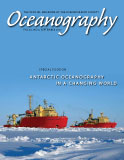First Paragraph
Moonstruck: A Celebration of Earth's Moon…
InOMN, it's called: International Observe the Moon Night. InOMN has become an annual event; it takes place this year on September 22, just before the full moon. Members of the InOMN team include scientists, educators, and moon enthusiasts from government agencies, nonprofit organizations, and businesses throughout the United States and around the world.
At First- and Third-Quarter Moon, Grab Your Umbrella
InOMNers may be lucky this year: the gathering is scheduled for a moon close to full. Otherwise, the skies might be obscured with rain clouds, found Randall Cerveny and Bohumil Svoma of Arizona State University and Russell Vose of the National Oceanic and Atmospheric Administration's National Climatic Data Center in Asheville, North Carolina.
Moon Phases: Visible In the Deep Sea…?
The moon's phase may affect rainfall and stream flow on Earth's surface, but could it also drive processes far, far below, in the depths of the sea?
Marine scientist Annie Mercier of Memorial University in St. John's, Newfoundland, and colleagues say the answer is yes. They found evidence of lunar periodicity in the reproduction of six deep-sea species. Release of gametes in free-spawning species, and of larvae in brooding species, peaked around the new and full moons respectively, says Mercier.
Sunset Sonata: Corals, The Moon, and "The Blue Pulse"
Shallow-dwelling corals also spawn on cue; they, too, may be timing the event to the phase of the moon. Coral reefs release eggs and sperm all at once for one, or at most a few, consecutive summer nights after sunset on the evenings after a full moon.
What's the signal that says "go"?

